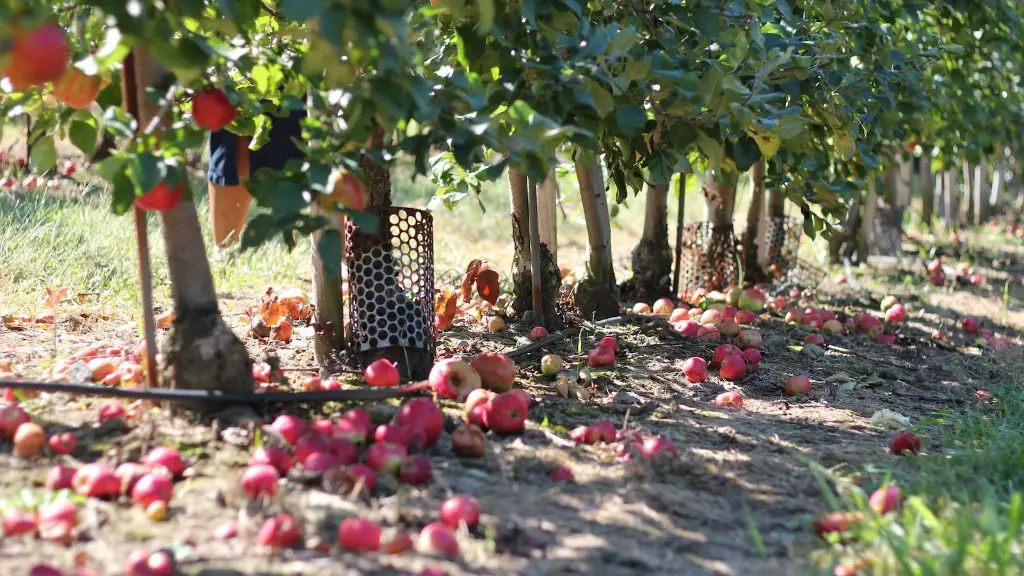Ornamental cherry trees are some of the most beloved landscape items spanning across centuries of traditional gardens and walks. The beauty, graceful appearance and vivid winter flowers of the ornamental cherry tree is what catches the eye, but how tall does an ornamental cherry tree grow?
When grown in a natural open landscape, cherry trees can reach heights of 25 to 35 feet, with the branches spreading out to form a roundish crown that spans up to 20 to 30 feet wide. But when grown in a restricted area, like a pre-planted area, the trees may barely grow to a height of 8 to 10 feet. That’s because the cherry flowers need a lot of light and air, which they don’t get when they are constricted by a narrow space.
The trees don’t tend to grow much taller during the first few years after planting, because the root systems need time to properly establish for the tree to thrive. As the trees start to age, the growth rate will increase and if the trees are given enough space, they can reach tall heights up to a possible 35ft tall, giving off a delightful appearance.
It is also important to note that different varieties of ornamental cherry trees have different grow cycles. Some grow slowly while others grow very quickly, so depending on the variety chosen, the mature size of the tree can vary. It is wise to speak to an arborist or a specialist to help choose the right variety for your garden.
Thanks to their strong root system, ornamental cherry trees have a resistance to strong winds, which makes them an ideal tree for areas that experience a lot of wind. Moreover, with their deep root system and wide trunk, these trees are not just beautiful, they are also very kid-friendly in that they are not at risk of toppling over from children running around them and playing.
For thousands of years, the ornamental cherry tree has been grown for its beauty and unique grace. Although it does take them up to several years to grow in height, the wait is worth it when it comes to enjoying the fullness of these trees in our gardens and landscapes. By choosing the right variety, researching proper care and giving the tree enough space to grow, you can enjoy the full beauty of the ornamental cherry tree for year-round appreciation.
General Care of the Ornamental Cherry Tree
The ornamental cherry tree requires moderate to full sun and regular watering, as well as proper protection from temperature drops and heavy winds. Any newly planted cherry trees should be watered deeply with a hose three or four times a week during their first year and should be kept in a wind-protected area. During the winter months, when the cherry tree has gone dormant, it should be kept in a slightly drier environment, making sure to still water deeply every few weeks.
Fertilizer should be applied every three to four years to keep the tree’s soil healthy. The fertilizer should be high-nitrogen, and applied at the start of the growing season in small amounts, so as not to overwhelm the tree. Pruning is another important aspect of caring for ornamental cherry trees; it is recommended to prune the tree in late winter, to allow for the tree to shape up properly as well as allowing for more sunlight and air to reach the flower buds.
The ornamental cherry tree’s bark is very ornate and delicate and can be easily damaged. To prevent this from happening cranberry doubles should be applied late winter and then again during the summer months in order to reduce cracking, splitting and any other issue that may arise.
Pests and Diseases
Ornamental cherry trees are usually disease- and pest-free, but like all other trees, it is advisable to check for any signs of damage or disease. The most common problem that one may find is aphids, which are usually seen on the branches or near the flowers. If they are present, they can easily be removed with a garden hose or by spraying the tree with an insecticide.
Another common problem found in ornamental cherry trees is a fungal disease called black knot. This is a type of mold that can be spread to other trees if not treated. The best way to treat the tree is to prune away any infected branches and spray the tree with a fungicide. It’s important to keep in mind that ornamental cherry trees can develop diseases and pests, so it’s important to keep a watchful eye on it and keep it healthy year-round.
Location and Planting Guide
Ornamental cherry trees should be planted in an area with moist soil, that receives at least 4-6 hours of direct sunlight. The tree should also be planted in an area where the temperature is not too extreme, as extreme summer or winter temperatures can cause the tree’s growth to slow.
The tree should be initially planted in a large container, to avoid shock and compression. It is important to note that cherry trees prefer having deep soil, so a depth of at least three feet should be maintained to allow the tree’s taproot to grow deeply. When initially planting the tree, it should be placed at the same height it was when it was shipped and steady soil pressure should be maintained around the tree’s roots.
Pruning the Ornamental Cherry Tree
Pruning an ornamental cherry tree is not a complicated process, however it is important to ensure that the tree is eventually kept thin and open to allow for light and air to penetrate throughout. The branches should be pruned back to their length in early spring, before the tree buds can form, and again late winter in order to shape the cherry tree’s canopy.
The lower branches of the tree should be removed and the canopy should be kept thinned out to avoid any branches from competing for light and air. The biggest branches of the tree should be left alone and only the smallest branches should be pruned, as these are the branches that are taking away from the tree’s appearance.
Enjoying the Ornamental Cherry Tree
The enormous beauty that the ornamental cherry tree offers has made it a classic addition to the garden for centuries. Although the height of an ornamental cherry tree may be somewhat of a mystery, once planted and cared for properly, the tree can reach up to 35 feet in height and offer a lush, colorful landscape to live in. Caring for the tree with regular watering and pruning, combined with planting in an open space and providing the right nutrients, will ensure that the tree will look its best year round and continue to be a pleasant part of the garden atmosphere.




